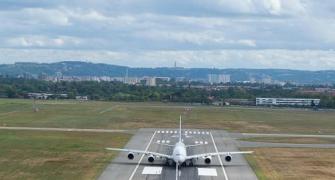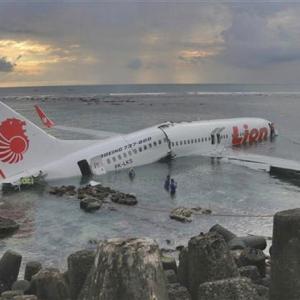
Supreme Court had asked govt to spell out policy guidelines on uneconomic routes
Domestic carriers and the civil aviation ministry are in a quandary after the Supreme Court sought to know if there was a policy allowing carriers to skip uneconomic routes.
Expressing its displeasure with airlines ignoring 'unviable routes', the SC Bench of Chief Justice T S Thakur remarked on Tuesday there should be a provision asking airlines to serve uneconomic routes as well.
The apex court asked the government to get back by March 9 about the policy.
The court was hearing an appeal of Air India in the matter of Shimla where the airline had stopped operations since 2012.
However, data from the Directorate General of Civil Aviation show airlines are complying with the route dispersal guidelines, which mandate them to deploy a part of their capacity on under-served routes.
At present, airlines are free to decide on the routes based on commercial considerations and there are no guidelines that compel airlines to fly to any specific route.
However, under the route dispersal norms, airlines should deploy 10 per cent of their metro capacity to category-II routes -- Jammu & Kashmir, northeastern states, Lakshadweep, and Andaman & Nicobar Islands.
Further, according to rules, one per cent of total capacity on metro routes needs to be deployed within Kashmir, northeastern states and so on.
These are known as category-IIA routes.
In case an airline does not fly between two metros, it has no obligation to fly to the category-II routes.
Shimla is not included in category-II or IIA routes.
During December, all scheduled airlines complied with mandatory capacity deployment requirements according to route dispersal guidelines.
The court’s observations are a point of bother for the government, which for the past several years tried to introduce a regional connectivity policy by offering sops to airlines.
“States like Himachal Pradesh, which are without air connectivity, are a telling comment on the state of regional aviation in the country.
"The court's comment need to be taken in the right spirit as it concerns public interest.
"I do not see how airlines can be forced to start commercial service as long as route dispersal guidelines are adhered to by them.
"Air India's route decisions are not always entirely commercial and, hence, asking for viability gap funding for Shimla routes is surprising especially after the Supreme Court’s intervention.
"The biggest viability gap funding Air India gets is in the form of tax payer-funded equity infusion,” said Kapil Kaul, CEO India of aviation consultancy Centre for Asia Pacific Aviation.
On Tuesday, the civil aviation ministry submitted to the court that Air India could lease ATR-42 aircraft to start the service to Shimla, but it would require viability gap funding from the state government to bridge the gap between costs and revenue.
The ministry said a second airport in Shimla can be considered considering limitations at the existing airport.
According to experts, the move to resume operations to Shimla is a good proposition.
They, however, cautioned against forcing airlines from launching flights without government support and appropriate infrastructure.
The civil aviation ministry’s submission did not enthuse the Bench headed by Thakur, who expressed ire on the airlines for focusing only on lucrative routes.
“The Chief Justice of India is right in asking for air connectivity on unviable routes.
"Shimla is after all a state capital and a major tourist destination,” said Amber Dubey partner and head of aerospace and defence at global consultancy KPMG.
However, he cautioned that it would be unfair to force airlines to fly on unviable routes.
“Most airlines have stressed balance sheets given the high cost of flying in India and carry-forward losses.
"It was only in 2015 that the airline sector finally showed an uptick thanks to the fall in aviation turbine fuel prices,” he added.
The image is used for representational purpose only. Photograph: Jewella C Miranda










